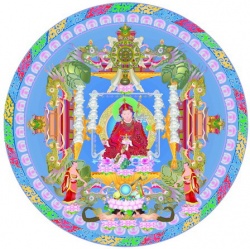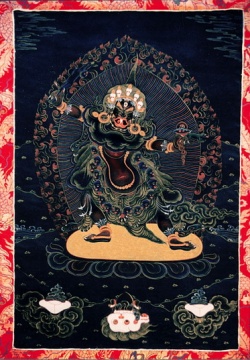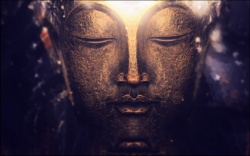The Samyutta Nikaya
The Samyutta Nikaya contains three suttas in which the Venerable Maha Kaccana displays his ingenuity in elaborating upon brief utterances of the Buddha: SN 22:3, SN 22:4, and SN 35:130. These suttas are different both in setting and character from the three analytical discourses of the Majjhima Nikaya. In all three Maha Kaccana is not dwelling in the midst of the Sangha in close proximity to the Buddha, but in Avanti, at the Osprey's Haunt on Precipice Mountain, presumably a remote place difficult of access. Then a lay devotee named Haliddikani, evidently quite learned in the Dhamma, comes to him and asks him to explain in detail a short discourse of the Buddha. Maha Kaccana's reply is addressed to the householder Haliddikani alone, not to a group of monks, and there is no subsequent confirmation of his exposition by the Buddha at the end of the discourse. It seems impossible to determine whether these exchanges took place during the Buddha's life or after his demise, but obviously, to have been incorporated into the Canon, reports of the discussions must have reached the main centers of the Buddhist community.
In SN 22:3, Haliddikani asks the elder to explain in detail the meaning of a verse from "The Questions of Magandiya," included in the Atthakavagga of the Sutta Nipata (v.844):
"Having left home to roam without abode,
In the village the sage is intimate with none;
Rid of sensual pleasures, without preference,
He would not engage people in dispute."
In responding to the lay devotee's request, the Venerable Maha Kaccana introduces a methodology that is strikingly different from his approach to interpretation in the three suttas of the Majjhima Nikaya. Here he does not simply elaborate upon the literal meaning of the Buddha's statement, drawing out its philosophical and practical implications as he did in those suttas. Instead he transposes the key expressions of the verse to a different level of discourse, treating these expressions, not merely as obscure terms in need of clarification and exemplification, but as metaphors or figures of speech that to be properly understood must be redefined in terms of their non-figurative meanings. He does this, as we shall see just below, by first eliciting from the selected figurative terms their implicit literal meanings and then mapping those meanings on to other, more systematic frames of doctrine. This technique was to become characteristic of the Pali commentaries in later centuries, and we might even regard Maha Kaccana's style of exegesis here as being, in certain respects at least, the original prototype of the commentarial method.
Taking up first the expression "having left home" (okam pahaya), Maha Kaccana treats the word "home," not as bearing the literal meaning of a place where people live, but as an elliptical reference to the "home of consciousness" (viññanassa oko). He explains that the "home of consciousness" is the other four aggregates — material form, feeling, perception, and volitional formations — which are here referred to as elements (dhatu); elsewhere these are described as the four "stations of consciousness" (viññana-thiti).[19] If consciousness is bound by lust to these four elements, one is said to move about in a home. If one has abandoned all desire, lust, delight, and craving for these four homes of consciousness, one is said to "roam about homeless" (anokasari). It should be noted that this last term does not itself occur in the verse, but Maha Kaccana has introduced it into his exegesis as a description of one who has abandoned home.
Next the elder explicates the phrase "to roam without abode" (aniketasari). He first defines the counterpart, "roaming about in an abode" (niketasari), which also does not appear in the verse. As before, Maha Kaccana treats this expression as a metaphor to be reformulated in terms of systematic doctrine. In this instance, rather than using the five aggregates as his scaffold, he draws in the six external sense bases. By being shackled to the sign of forms (sounds, odors, etc.), by moving about in the abode of forms, etc., one is called "one who roams about in an abode." When one has abandoned all bondage to the sign of forms, etc., cut them off at the root, then one is said to "roam without abode."
The remaining sections of the exposition proceed more literally, and simply explicate, with straightforward definition, the meaning of the phrases used in the verse, always in terms of contrasting pairs. One who is "intimate with none in the village" is defined as a bhikkhu who keeps aloof from lay people and their worldly concerns. One "rid of sensual pleasures" is one devoid of lust and craving for sensual pleasures. One "without preferences" (apurakkharano) is one who does not yearn for the future. And one who "would not engage people in dispute" is one who does not become embroiled in quarrels and disputes over the interpretation of the Dhamma.
In the next sutta (SN 22:4) Haliddikani asks how one should understand in detail the following brief statement of the Buddha, found in "The Questions of Sakka":[20] "Those recluses and brahmans who are liberated by the full destruction of craving are those who have reached the ultimate end, the ultimate security from bondage, the ultimate holy life, the ultimate goal, and are best among devas and humans." Maha Kaccana explains:
"Householder, the desire for the material-form element, (for the feeling element, the perception element, the volitional-formations element, the consciousness element), the lust, the delight, the craving, the engagement and clinging, the mental standpoints, adherences, and underlying tendencies regarding it: through their destruction, fading away, cessation, giving up, and relinquishment, the mind is called well liberated.
"Thus, householder, it is in such a way that the meaning of what was stated in brief by the Blessed One should be understood in detail."
In a third sutta (SN 35:130) Haliddikani begins a query with a quotation from the Buddha, but this time he does not ask: "how should the meaning of this brief statement be understood in detail?" Rather, he simply requests the Venerable Maha Kaccana to explain the following excerpt from the Dhatusamyutta (SN 14:4): "Bhikkhus, it is in dependence on the diversity of elements that there arises the diversity of contacts; in dependence on the diversity of contacts that there arises the diversity of feelings."
The Buddha himself had explained this assertion by showing how the different kinds of elements condition their corresponding kinds of contact and feeling: "In dependence on the eye element there arises eye-contact; in dependence on eye-contact there arises feeling born of eye-contact." And so for the other sense faculties. The Venerable Maha Kaccana, however, does not merely parrot the Buddha's analysis, but carries the divisions down to a finer level:
"Here, householder, having seen a form with the eye, a bhikkhu understands one that is agreeable thus: 'Such it is.' In dependence on eye-consciousness and a contact to be experienced as pleasant, there arises a pleasant feeling. Then, having seen a form with the eye, a bhikkhu understands one that is disagreeable thus: 'Such it is.' In dependence on eye-consciousness and a contact to be experienced as painful, there arises a painful feeling. Then, having seen a form with the eye, a bhikkhu understands one that is a basis for equanimity thus: 'Such it is.' In dependence on eye-consciousness and a contact to be experienced as neither-painful-nor-pleasant, there arises a neither-painful-nor-pleasant feeling."
The same analysis is applied to each of the other sense faculties. Thus, while the Buddha merely differentiates the contact and feeling by way of the sense faculty, the Venerable Maha Kaccana distinguishes within each sense sphere three qualities of the object — agreeable, disagreeable, and indifferent; three qualities of the contact — to be felt as pleasant, to be felt as painful, and to be felt as neither; and three qualities of the feeling — pleasant, painful, and neither-painful-nor-pleasant. These triads are then collated and shown to originate in a conditional relationship: the quality of the object conditions the quality of the contact; the quality of the contact conditions the quality of the feeling. As the entire process is said to be contemplated by a bhikkhu endowed with understanding, this also implies that he has the capacity for overcoming the bondage to feelings by means of insight into their conditioned origination.




